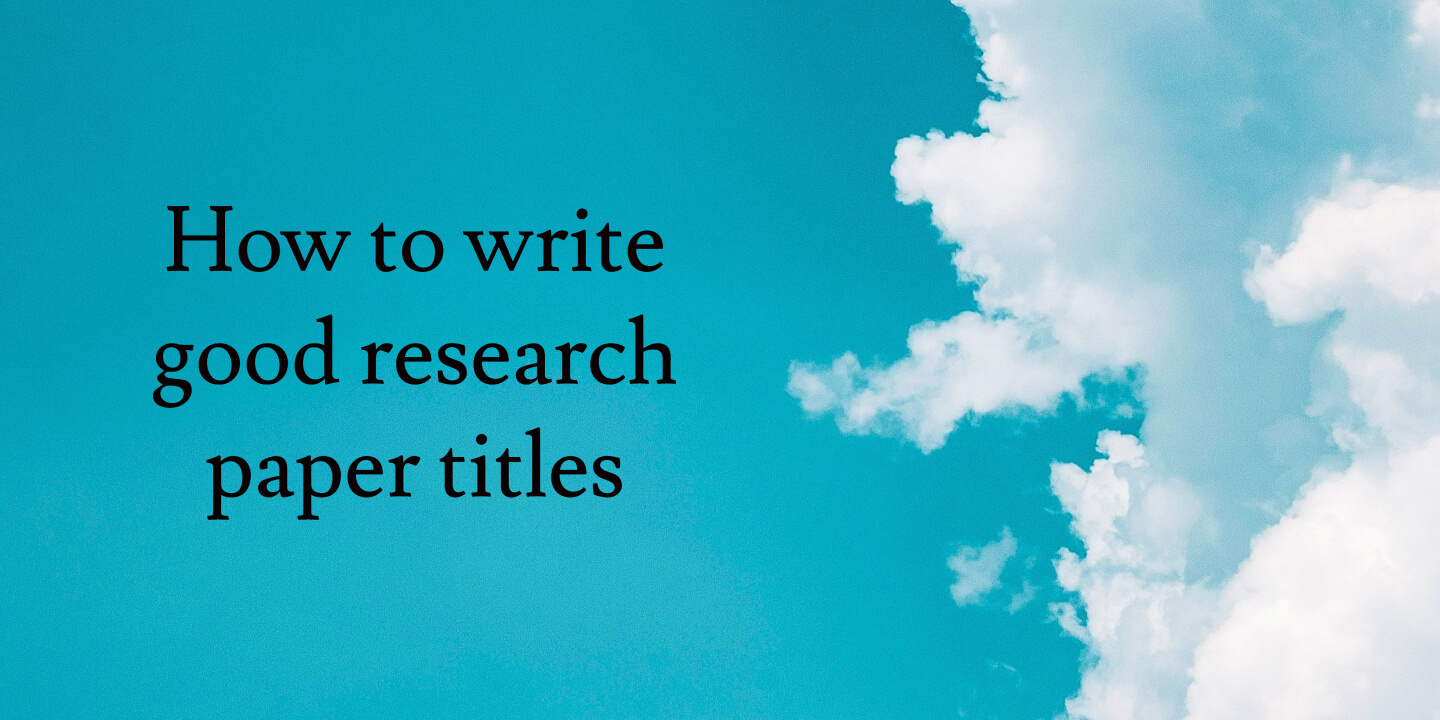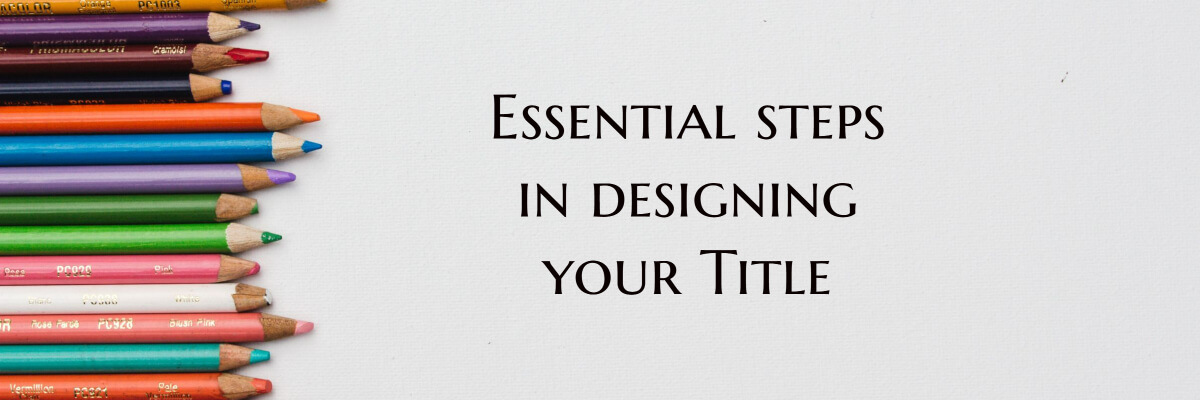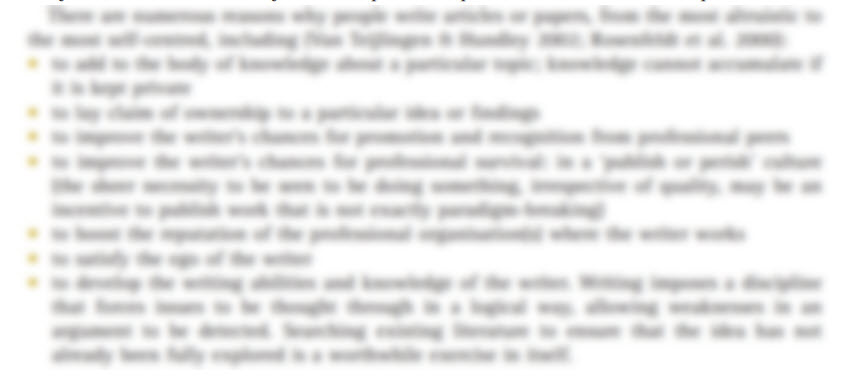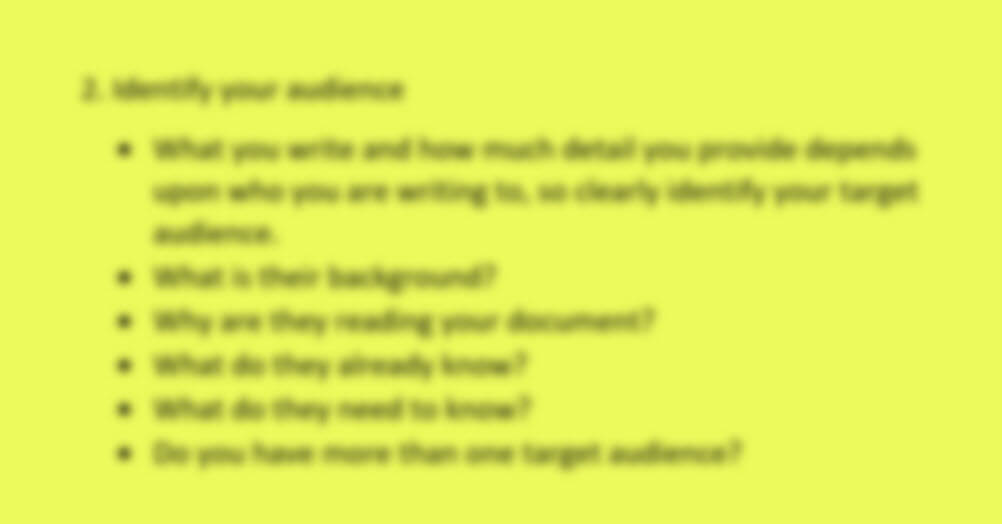Your title is the first and most important step in engaging your reader. It should be concise, interesting and summarise the essential content of the document. Any title that is lengthy, overly complex, ambiguous or misleading can turn away prospective readers. This writing guide gives an overview of the different types of titles and explains the essential steps in designing your title.
Title structure
Titles can be sentence fragments, complete sentences or compound sentences with the second sentence typically following a colon.
To help the paper appear in search results, it is common practice to place keywords in the title. Keywords used in the title should be placed in the beginning in case only a fragment of the title appears in the search results.
Terms used to describe types of titles
Common terms used to describe different types of research paper titles are Descriptive, declarative, interrogative, suggestive, humorous and combination titles.
Descriptive titles or indicative titles
Descriptive titles state the subject, topic, design, purpose or methods of the project. For example:
- ‘Effects of natural forest and tree plantations on leaf-litter frog assemblages in Southern Brazil.’ (Cicheleiro et al. 2021).
- ‘An efficient incremental learning mechanism for tracking concept drift in spam filtering.’ (Jyh-Jian et al. 2017).
Declarative or Informative titles
These titles give the main findings or result of the study. For example:
- ‘Novel flight style and light wings boost flight performance of tiny beetles.’ (Farisenkov et al 2022).
- ‘Cause of hypereosinophilia shows itself after 6 years: Loa loa.’ (Hicks et al. 2022).
There is some concern that presenting the results or conclusions in the title of a paper will appear presumptive: that titles containing a definitive statement or final conclusion of a study, might prove problematic if that finding is later disproved.
Some journals prefer informative titles. For example, the Journal of Clinical Epidemiology has “… an editorial policy of “more informative titles” (MITs) that crisply and concisely tell our readers what our authors found in their research. A MIT states the study type and summarizes its key findings, using the past tense for individual studies and the present tense for systematic reviews.” The idea is that titles for small individual studies should be written in past tense to allow future studies to overrule or disagree with their findings, while titles should be written in present tense for studies that are unlikely to be over-ruled by later studies: i.e. literature reviews. Some research has also demonstrated that “articles with short titles describing the results are cited more often.” (Paiva et al. 2012).
Interrogative titles
Interrogative titles or titles phrased as a question. The use of questions in titles can create interest by making the reader immediately wonder what the answer might be. It is also a concise way of presenting the research topic.
For example:
- ‘Does adding video and subtitles to an audio lesson facilitate its comprehension?’ (Zheng et al. 2022).
- ‘Microbial defenses against mobile genetic elements and viruses: Who defends whom from what?’ (Eduardo et al. 2022).
Suggestive titles
These are titles that are slightly ambiguous or overly brief to hint or suggest what the findings might be, presumably to create suspense to entice the reader to find out what the answer is. For example:
- ‘Drawing to improve metacomprehension accuracy’. (Thiede et al. 2022).
- ‘The puzzle of high temperature superconductivity in layered iron pnictides and chalcogenides.’ (Johnston 2010).
Humorous or colloquial title
These are titles that hope to attract interest through humour or common-use sayings, colloquialism or metaphors. These types of titles can be used to good effect. However, be mindful that colloquialisms might not make sense to readers from different language or cultural backgrounds.
For example:
- ‘miR miR on the wall, who's the most malignant medulloblastoma miR of them all?’ (Wang et al 2018).
- ‘One ring to multiplex them all’ (Torres-Company 2017).
- ‘Sauropod farts warmed the planet.’ (Marshall 2012).
Combination titles
Combination titles are those that include a combination of different types listed above.
The following example uses a colloquialism in the key title with the findings mentioned in the sub-title:
- ‘Standing out in a crowd: Intraspecific variability in dorsal patterning allows for photo-identification of a threatened anuran.’ (Gould et al. 2021).
The following example has the following structure: ‘Topic: results of study’
- Plastic Pollution in the World's Oceans: More than 5 Trillion Plastic Pieces Weighing over 250,000 Tons Afloat at Sea (Eriksen et al. 2014).
Which type is better?
There are conflicting views which type of title is better. There are arguments for and against different types, with research findings presenting the pros and cons of different types of title. Before you decide which is best, first look at how titles are commonly structured in recently published journals within your discipline.
Essential steps in designing your title
The following steps will help you design your document title.
1. Read the Instructions to Authors
Once you have selected a journal, review the types of titles recently published and read the Instructions to Authors to learn what the journal requires for paper titles. Instructions regarding titles are often brief. For example:
- Elsevier’s Guide for Authors “Title - Concise and informative. Titles are often used in information-retrieval systems. Avoid abbreviations and formulae where possible.”
- Plos One Submission Guidelines state that titles should be “…Specific, descriptive, concise, and comprehensible to readers outside the field.” and “…written in sentence case (only the first word of the text, proper nouns, and genus names are capitalized). Avoid specialist abbreviations if possible. For clinical trials, systematic reviews, or meta-analyses, the subtitle should include the study design.”
2. Consider your audience
Although the expected audience is broadly set by the scope of the journal, you still need to identify who will be interested in your paper. Who is your target audience? Are they scientists who mostly work in your field or will they include researchers from other disciplines? Consider what aspects of your project would attract your target audience and whether or not you can include these in your title.
3. Decide what aspects of your study to include in your title
As outlined above (Types of titles) decide whether you want to describe the process (descriptive) the result (informative) the research question or problem (integrative) or a combination of these factors.
Description of methods and study design
Titles of research papers, reports and conference proceedings often contain standard research methods. For example:
- ‘Plant-based diets and incident cardiovascular disease and all-cause mortality in African Americans: A cohort study.’ (Weston et al. 2022).
- ‘Using scale modelling to assess the prehistoric acoustics of Stonehenge.’ (Cox et al. 2020).
- ‘The use of chronosequences in studies of ecological succession and soil development.’ (Walker et al 2010).
Description of study subjects and location
Titles often just describe the key study subject, and also often including habitat or location. For example:
- ‘Making (remote) sense of lianas.’ (van der Heijden 2022).
- ‘The vulnerability of native rangeland plant species to global climate change in the West Asia and North African regions’ (Ouled Belgacem & Louhaichi 2013).
How specific or general should your title be?
Your title should be unique to your project. Hopefully, no one else is writing a paper exactly the same as you, and your title should reflect this. If your title is too broad or general, then you may give the impression that the study is larger than it is or that it is a literature review. This is when it is important to make a distinction between ‘topic’ (general) and ‘title’ (specific). Unless you are writing a literature review or presenting a large-scale study, don’t give your research topic as your title.
Including information on the scope of the study will also help the reader understand the magnitude of your study and from this, the importance and implications of the findings. In the following example, “in highway bridges” gives the scope of the study:
- ‘Finite element based fatigue assessment of corrugated steel web beams in highway bridges.’ (Wang & Wang 2015).
Avoid making your title too long with too much specific detail. For example, perhaps this title is too long:
- ‘Use of open-text responses to recode categorical survey data on postpartum contraception use among women in the United States: A mixed-methods inquiry of Pregnancy Risk Assessment Monitoring System data.’ (Richards et al, 2022).
4. Consider your reader’s behaviour
Assume your reader only has a short time to decide if your title is relevant and that they will only review the abstract if the title interests them. Titles that include standard procedures, common cause-effect scenarios or well-known research topics, might be overlooked in preference for titles describing unique approaches or interesting findings.
5. Check that your title is clear and easy to read
Your main message must be clear. Your titles don’t have to be grammatically-complete sentences, but make sure they make sense, especially if you have tried to shorten them by cutting out words. Don’t sacrifice clarity for brevity by making your title obscure.
Beware of using adjectival-noun strings in your titles. This is when authors try and be more concise by placing too many adjectives in front a single noun making it difficult to decipher whether each adjective is actually modifying the root noun or another word in the adjectival-noun string. Take an example from a student report: ‘Australian insecticide control failure.’ (Anon.) This might be interpreted as:
- The failure of insecticide to control something in Australia.
- The failure of Australian insecticide to control something somewhere else.
- The failure to control [the use of] Australian insecticide.
Another unclear example: ‘Post head emergence spring radiative frost damage of winter cereals.’ (Anon.) It could be made even longer: ‘Winter cereal post head emergence spring radiative frost damage.’
6. Check your title length
The shorter the title, the easier it will be to read but only to a certain point. Too short and you risk sacrificing your meaning. Also, If you leave out too much detail, the title may appear too general and mislead the reader. If the reader has to guess what the meaning, you increase the chance of losing them. Check that your title is not too ambiguous, cryptic or inadvertently misleading. An ambiguous media release example:
- ‘Lupins show healthy potential for increased human consumption.’ (Australian Food News 2008).
7. Check that your title is concise
Titles can be made more concise by removing unnecessary repetition and detail. Common research phrases can be removed without affecting the meaning or structure of the title. Examples of these research phrases include ‘The influence of...’, ‘The role of..’, ‘Effects of..’, ‘Observations of..,’ ‘Studies on...’
For example: ‘Annual variation in the distribution of summer snowdrifts in the Kosciuszko alpine area, Australia, and its effect on the composition and structure of alpine vegetation.’ (Edmonds et al. 2006) [25 words] could be reduced to: “Distribution of summer snowdrifts influences composition and structure of Kosciuszko alpine vegetation, Australia” [13 words].
8. Ways to make your title more interesting
Ask a question
By writing a title in the form of a question you are immediately inviting the reader to think. For example:
- ‘Whose shoulders is health research standing on? Determining the key actors and contents of the prevailing biomedical research agenda.’ (Testoni et al. 2021).
Be humorous or focus on the unusual or unexpected
Mildly humorous titles immediately engage the reader while unusual or unexpected tiles create curiosity.
- ‘On human odour, malaria mosquitoes, and Limburger cheese.’ (Knols 1996).
Final considerations
My key advice is, ensure your title is concise, easy to read (for your target audience), not too long and adequately reflects your study’s design or purpose (not too general or too specific).
Checklist:
- Is it hard to read?
- If it is a question, does it make your reader wonder what the answer is?
- If it is a summary of your methods, are these methods unique or reveal a fresh approach or are they just standard and well-known and therefore unlikely to stand-out?
- If it is the answer or conclusion to your problem, are you risking letting the reader think they now don’t need to read the paper? Or might your conclusion-title be a way to hook your reader into finding out more about your study?
- Does it create interest or curiosity?
© Dr Marina Hurley 2022 www.writingclearscience.com.au
Any suggestions or comments please email admin@writingclearscience.com.au
Find out more about our online science writing course...
Now includes feedback on your writing Learn more...
SUBSCRIBE to the Writing Clear Science Newsletter
to keep informed about our latest blogs, webinars and writing courses.
FURTHER READING
- Should we use active or passive voice?
- 10 writing tips for the struggling ESL science writer
- Co-authors should define their roles and responsibilities before they start writing
- How to write when you don’t feel like it
- When to cite and when not to
- Back to basics: science knowledge is gained while information is produced
- How to build and maintain confidence as a writer
- If science was perfect, it wouldn’t be science
- The essentials of science writing: What is science writing?
- 8 steps to writing your first draft
- Two ways to be an inefficient writer
- Work-procrastination: important stuff that keeps us from writing




















